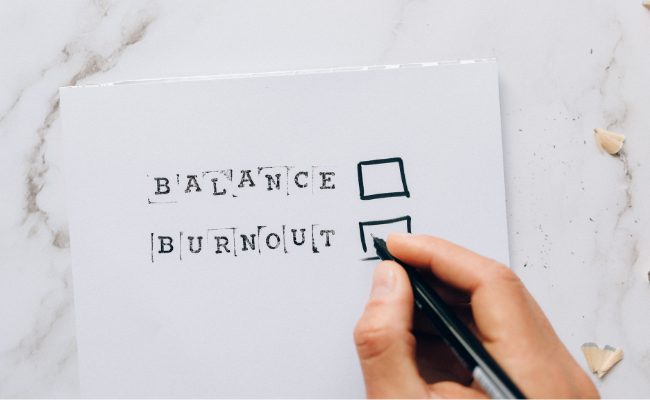Understanding Burnout: A Reflection
We can certainly learn how to be more efficient, how to be in high-performance, how to make a bigger positive impact, and still have the energy to enjoy the fruits of our labor—and that is really important.
Ana Melikian
Today I dive into a much buzzed-about topic: Burnout, and the multiple dimensions attached to the word. How can we address such a prevalent issue in a way that helps us engage more fully with our lives?
I discuss:
- What is burnout?
- Measuring burnout and your burnout profile
- Burnout red flags to watch out for
What is burnout?

Most people have an intuitive idea of what burnout is, how it feels, and what causes it. We generally understand that it’s an important topic in need of study and research.
But because of this, it’s even more important to define burnout comprehensively.
Burnout is broken into three dimensions by the World Health Organization:
One: Depletion and exhaustion
This dimension is the one people think of most. Lack of energy, burning the candle from both ends, a spent match—typical depictions of being 100% void of reserves.
Two: Increased mental distance from responsibilities
Cynicism, disconnection from one's purpose, being weighed down by bureaucracy and red tape. Feeling powerless. And, as a result, losing the will to engage with our work.
Three: Reduced professional efficacy
Lack of tangible results from our work, we don’t feel that we’re producing value or being efficient. A dragging, sluggish crawl through the day that doesn't seem to lift.
Looking at these dimensions and a more nuanced conversation around burnout, it’s simple to recognize how these trademarks contribute to severe unfulfillment and lack of purpose. But that’s not the end.
Measuring burnout and your burnout profile

A typical burnout profile will be someone feeling exhausted, drained, no more to give, feels disconnected from work, etc. Very high in exhaustion, very high in cynicism, and very low in professional efficiency.
On the opposite side of the spectrum, we have the engaged profile. Somebody that feels energized with work, connected and motivated—with the purpose and mission of their work clear. They feel the work they do produces results and matters. However, this approach comes with the risk of over-extension, which eventually can slip into burnout.
In between these two extremes, other profiles show up in different ways. Burnout has multiple ways of manifesting itself. By understanding these nuances, we can prevent ourselves from swinging to one extreme or the other.
I tend to fall into one of the in-between profiles, the over-extension one—picture the frog in the pot, with the water temperature slowly increasing, but not noticing the danger until it’s too late. I’m still attached to my purpose but am pushing too much, trying too hard, and getting frustrated with the results I’m getting.
Under those conditions, we can push ourselves to keep going even when we have nothing left, due to a strong belief in our work and its importance.
That is my rationale for what happened to me. When I had my cancer in 2016, I was exhausted, waking up tired, but I kept going and going. That is probably not why I had cancer—there are so many other reasons we don't understand—but we know that chronic stress isn't healthy for anybody. In one way or the other, that will reflect in our physical and psychological health and wellness.
Burnout red flags to watch out for

I am on a mission to help us identify where we are in terms of over-extension, seeing if we are connected with our mission and how effective we are in all these dimensions. To help us be aware. To move us into more energy, more flow, to allow us to have a bigger impact while avoiding burnout.
To have the time and energy to enjoy all the other elements of our lives.
Burnout red flags to watch out for:
- Telling ourselves we don’t have time to do what we love
- For example, if I catch myself saying I don’t have time for reading, that is a big red flag for me
- Actively choosing work over time with family and friends
- For example, putting off a date with a spouse to work late (again and again)
- Not building in times for reflection and pausing
- For example, rushing into each task until they all bleed together from sunup to sundown
I believe if we learn how to increase our positive impact while avoiding burnout in ourselves and the people around us, we can make a bigger positive impact. We can unleash our human potential out there in a big way, and in a way that we can enjoy the results of work and our life more fully.
How have you over-extended yourself? What have you done to address burnout in your own life?
Please feel free to email me with your burnout story at my email, [email protected], or leave a comment!
Catch the full episode that inspired this post for further insight into burnout.








